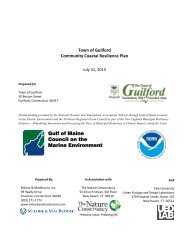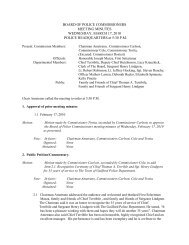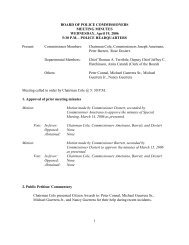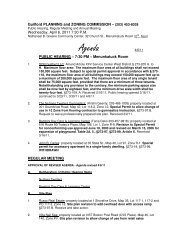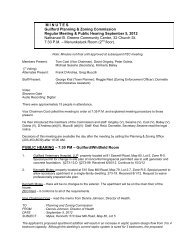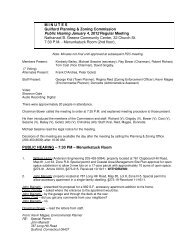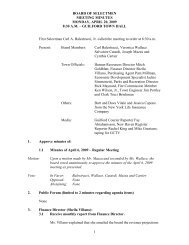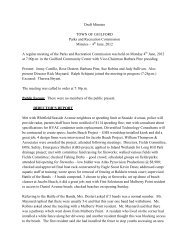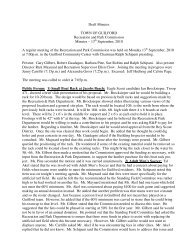Natural Resource Inventory and Assessment - Town of Guilford
Natural Resource Inventory and Assessment - Town of Guilford
Natural Resource Inventory and Assessment - Town of Guilford
You also want an ePaper? Increase the reach of your titles
YUMPU automatically turns print PDFs into web optimized ePapers that Google loves.
Invasive plants in <strong>Guilford</strong>’s upl<strong>and</strong>s include Japanese barberry, Asiatic bittersweet, autumn olive, winged<br />
euonymus, honeysuckle, multiflora rose, <strong>and</strong> Norway maple, among others. (See list in Appendix D-2.)<br />
Overabundant species are native species that have thrived in response to changes in l<strong>and</strong> use to the point<br />
that they threaten populations <strong>of</strong> other native species. For example, raccoons <strong>and</strong> opossums, which thrive<br />
in a suburban l<strong>and</strong>scape, prey on ground-nesting birds. Also, overpopulation <strong>of</strong> deer has actually altered<br />
the structure <strong>and</strong> composition <strong>of</strong> <strong>Guilford</strong>’s forests. Deer eat acorns <strong>and</strong> oak seedlings <strong>and</strong> may hamper<br />
regeneration <strong>of</strong> oaks. At the same time they tend to avoid beech, birch, black cherry, which tend to<br />
increase in heavily browsed areas. Deer browse has nearly eliminated forest herbs such as orchids, resulting<br />
in ground cover dominated by ferns, mosses, <strong>and</strong> grasses.<br />
Sources <strong>of</strong> stress: horticultural introduction; spread <strong>of</strong> seeds via vehicles, animals, clothing, etc<br />
Wildlife disturbance can be a significant threat to reclusive animals or those such as nesting or feeding<br />
birds that are particularly sensitive at times during their life cycles. Forests close to developed l<strong>and</strong> are<br />
subjected to human influence, including domestic pets that prey on wildlife.<br />
Sources <strong>of</strong> stress: habitat fragmentation, incompatible recreation, domestic pets, incompatible<br />
agricultural practices (See Loss <strong>of</strong> habitat.)<br />
Pests/pathogens: Tree blights have caused huge losses, even <strong>of</strong> entire species <strong>of</strong> trees. Major tree<br />
blights have all but eliminated two native species <strong>of</strong> trees from <strong>Guilford</strong>’s forests. One, a fungal blight<br />
imported in wood products from Europe eliminated the chestnut in the early 1900s. Another, Dutch elm<br />
disease, a fungal disease carried by both native <strong>and</strong> non-native bark beetles, arrived on this continent in<br />
contaminated elm veneer in the 1930s. Today few American elms survive. The gypsy moth has repeatedly<br />
stripped local forests <strong>of</strong> their leaves. The hemlock wooly adelgid, which is an insect, has wiped out nearly all<br />
eastern hemlocks in <strong>Guilford</strong>. Others pests <strong>and</strong> blights include ash blight, dogwood decline, <strong>and</strong> others.<br />
Sources <strong>of</strong> stress: wind-blown, transported materials<br />
Over-harvest/over-collection <strong>of</strong> a species can lead to its decline, particularly if it requires a long time to<br />
mature <strong>and</strong> produces few <strong>of</strong>fspring. For example, spotted turtles <strong>and</strong> wood turtles are extremely susceptible<br />
to even relatively low levels <strong>of</strong> casual collecting if it persists over time.<br />
Sources <strong>of</strong> stress: collectors, poacher for pet trade<br />
References<br />
Anderson, M. 2001. Multiple Scale Conservation <strong>of</strong> Matrix Forest: Thinking Inside the Blocks. Draft unpublished<br />
paper for The Nature Conservancy<br />
Connecticut Department <strong>of</strong> Environmental Protection, Aquifer Protection Program<br />
http://dep.state.ct.us/wtr/aquiferprotection/index.htm<br />
Connecticut Department <strong>of</strong> Environmental Protection. 2004. Connecticut Vegetation Organized by <strong>Natural</strong><br />
Community Types. Hartford, CT<br />
Cronon, W. 1983. Changes in theLl<strong>and</strong>. New York: Hill <strong>and</strong> Wang<br />
Farnsworth, E. 2004. The <strong>Natural</strong> World <strong>of</strong> the Traprock Ridges: Dry <strong>and</strong> Warm Alternates with Cool <strong>and</strong><br />
Moist. Connecticut Woodl<strong>and</strong>s. Middlefield, CT: Connecticut Forest <strong>and</strong> Park Association<br />
Hammerson, G.A. 2004. Connecticut Wildlife: Biodiversity, <strong>Natural</strong> History, <strong>and</strong> Conservation. Hanover, NH:<br />
University Press <strong>of</strong> New Engl<strong>and</strong><br />
Jorgenson, N. 1978. A Sierra Club <strong>Natural</strong>ist’s Guide: Southern New Engl<strong>and</strong>. San Francisco: Sierra Club Books<br />
LaBarbera, L., T. Rumpf, P. Sharp <strong>and</strong> H. Woolsey. 1978. Ecological Reconnaissance Survey <strong>of</strong> <strong>Town</strong>-owned<br />
Properties. <strong>Guilford</strong>, CT: <strong>Guilford</strong> Conservation Commission<br />
Massachusetts Audubon Society. 2004. Grassl<strong>and</strong> Birds<br />
http://www.massaudubon.org/Birds_&_Beyond/grassl<strong>and</strong>/index.php<br />
Meyer, J.L. et al. 2003. Where Rivers are Born: The Scientific Imperative for Defending Small Streams <strong>and</strong> Wetl<strong>and</strong>s.<br />
American Rivers <strong>and</strong> Sierra Club<br />
<strong>Natural</strong> <strong>Resource</strong> <strong>Inventory</strong> <strong>and</strong> <strong>Assessment</strong> <strong>Town</strong> <strong>of</strong> <strong>Guilford</strong>, CT D7<br />
Upl<strong>and</strong>s



